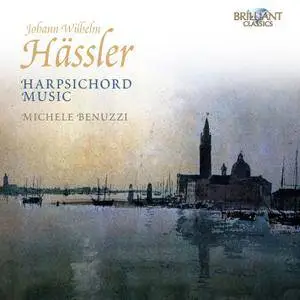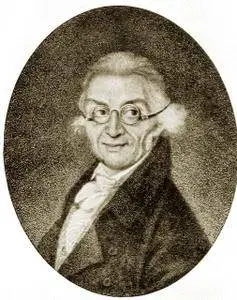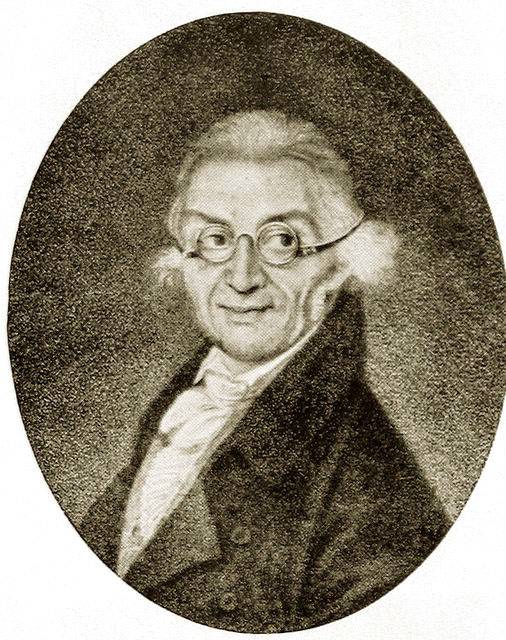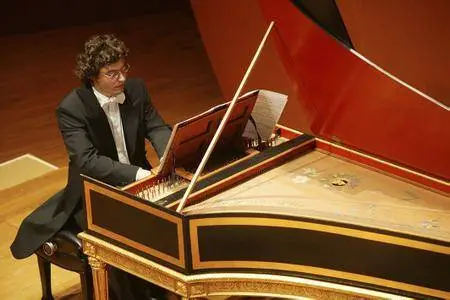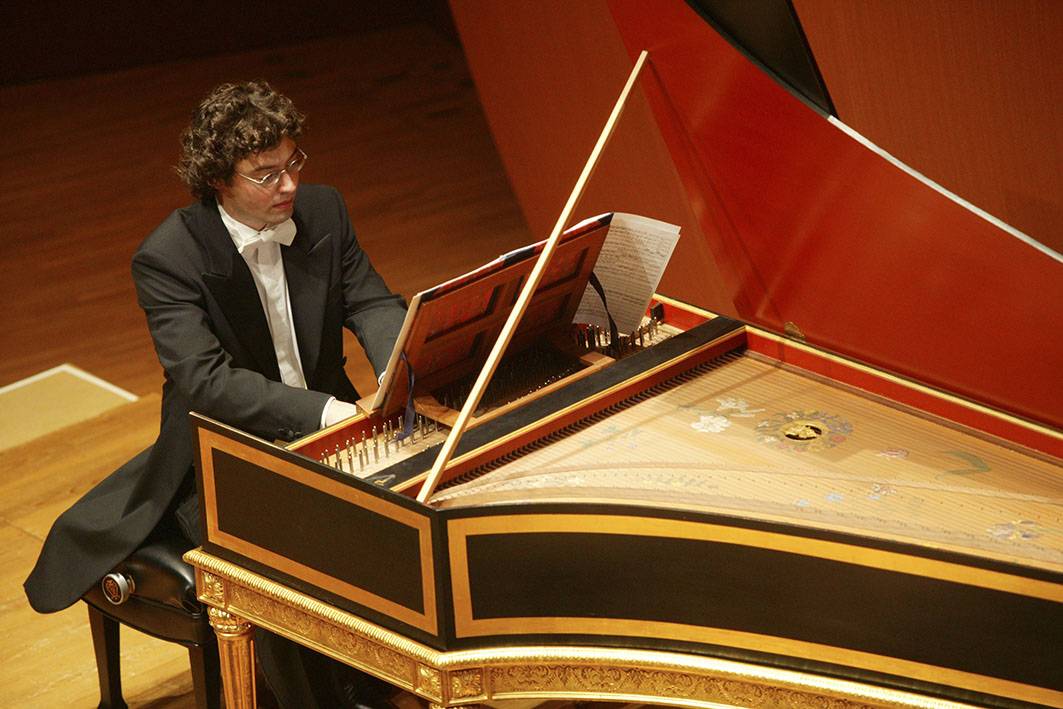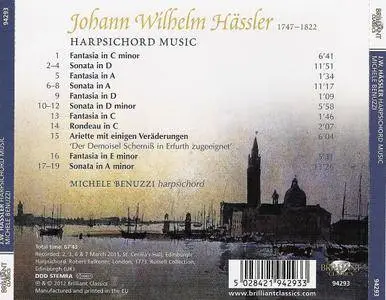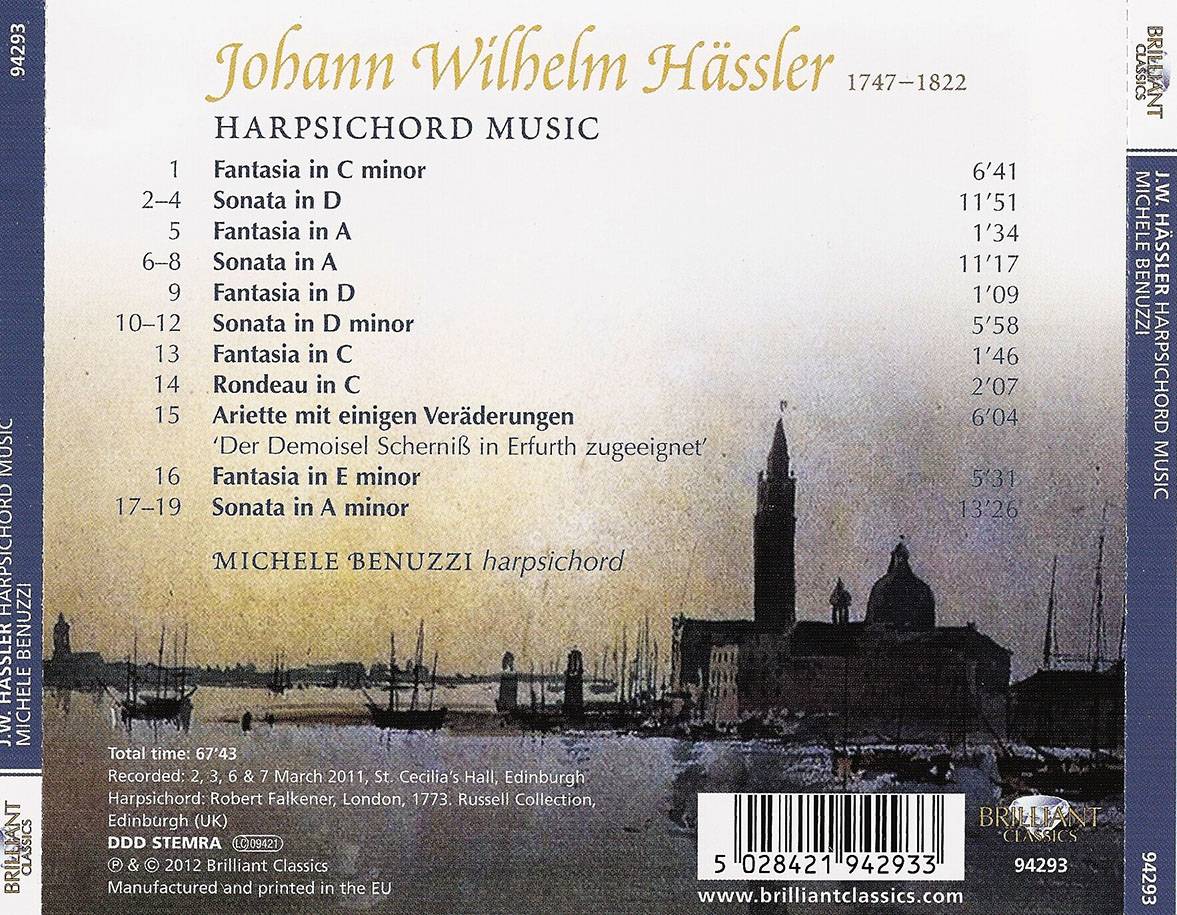Michele Benuzzi - Johann Wilhelm Hässler: Harpsichord Music (2012)
EAC | FLAC | Image (Cue&Log) ~ 422 Mb | Mp3 (CBR320) ~ 164 Mb | Scans included
Genre: Classical | Label: Brilliant Classics | # 94293 | Time: 01:07:42
EAC | FLAC | Image (Cue&Log) ~ 422 Mb | Mp3 (CBR320) ~ 164 Mb | Scans included
Genre: Classical | Label: Brilliant Classics | # 94293 | Time: 01:07:42
Johann Wilhelm Hässler was a great and famous keyboard virtuoso in the second half of the 18th century. His style forms a bridge between the Baroque and the early Classical era, a period of “Sturm und Drang”, highly virtuosic and extravagant in its expression of feelings and character. Harpsichordist Michele Benuzzi undertook thorough research into this music, some of which was formerly attributed to Wilhelm Friedemann Bach, before he prepared the present edition, as well as writing the extremely informative liner notes. Played on a magnificent historic 18th century instrument from the Russell Collection in Edinburgh. New Premiere Recording.
Although he is almost completely unknown today, Johann Wilhelm Hässler (1747–1822)—not to be confused with the Renaissance-era composer whose name is spelled without an umlaut—emerges from this CD as one of the unsung heroes of the later 18th century. You’d hardly know it from the brief article in New Grove, and if you were to search for a recording, either on ArkivMusic or in the Fanfare Archive, you’d come up empty-handed. The present CD is therefore almost certainly a premiere recording.
Hässler stood in the front ranks of the vanguard that swept through German music after the death of Sebastian Bach. As nephew of one of the last pupils of Bach, Hässler naturally had the essence of the learned German keyboard style coursing through his veins. His later interactions with Emanuel Bach and W. A. Mozart further shaped his career and set him on a new course—in 1789 he engaged in a famous keyboard contest with the latter, which ended in a draw and caused Mozart to utter some uncharacteristically unkind remarks. Ensuing concert tours took Hässler all over Europe, to great acclaim. He moved to England in 1790, and two years later to Russia, where he entered the service of the Grand Duke. Hässler published large quantities of keyboard music, especially during his Russian years. He is credited with nurturing the nascent generation of Russian pianist/composers at the turn of the century, but it’s fun to speculate what influence his unique blend of erudition (learned from his uncle) and Empfindsamkeit (acquired from Emanuel Bach) might also have had on composers such as Beethoven, Weber, and Chopin.
The music is endlessly varied and inventive. The melodies are inspired, and Hässler uses them in novel ways, adding frequent chromatic alteration and rhythmic variation. The opening movements of the sonatas are typically bipartite in structure—essentially the sonata style inherited from Emanuel Bach. The concluding sonatas movements are usually cast as a rondo, with the exception of the A-Major Sonata, which ends with a Scherzo-Allegro. The fantasies once again pay homage to Emanuel Bach, but are usually less ruminative and more rhythmically active.
The young Italian harpsichordist Michele Benuzzi covers himself in glory with this release. He is the ideal interpreter to bring this music to light: highly sensitive to the gesture and emotion of the music, yet capable of carrying the musical narrative forward in telling fashion. The liner notes recount Benuzzi’s initial encounter with the music of Hässler, beginning with a mysterious Fantasy in C Minor, attributed to Friedemann Bach, that Benuzzi first heard on an old recording. Subsequent investigations failed to produce the piece—evidently, it was not part of Friedemann Bach’s oeuvre . Quite accidentally Benuzzi discovered an ancient edition of piano music called Le Trésor des pianists in the library. Contained therein was the music to the Fantasy (eureka!), which bore the inscription “J. W. Hässler. 1776.” Further trips to the library yielded a veritable mountain of Hässler’s music. The rest, as they say, is history.
Benuzzi has chosen an original harpsichord by Robert Falkener (London, 1773) in the Russell Collection, Edinburgh, for his recording. Clearly, this is music suited for an expressive keyboard such as the fortepiano or clavichord; at first, I thought the choice of harpsichord would prove to be a handicap. Benuzzi justifies his choice by saying that a good interpreter can fully exploit the sonority and characteristics of every instrument, whether harpsichord, piano, or clavichord, to suit late 18th-century music. Fair enough—given Benuzzi’s prowess, this program would have been successful on just about any keyboard.
The instrument has a rich, dark sound, with excellent balance between the registers. Original English harpsichords tend to be rare on CD; after hearing this recital, you’ll wonder why more haven’t been recorded. The sessions took place in St. Cecilia’s Hall in Edinburgh, where the Russell Collection is housed. Visitors to the Russell Collection know that in addition to housing the instrument collection (one of the most extensive in Europe), the hall is a noted concert venue with excellent acoustics. The recording fully captures that ambience, at the same time presenting the harpsichord in a natural perspective, as if the listener were seated six feet away or so. Absolute highest recommendation.Review by Christopher Brodersen, Fanfare
Johann Wilhelm Hässler is one of the many little-known composers from the second half of the 18th century. They are overshadowed by either the sons of Bach or the classical masters Haydn and Mozart. At least one composition from Hässler's pen is relatively well-known: a Fantasia in c minor was long attributed to Wilhelm Friedemann Bach, and is still recorded now and then as being from his pen. The fact that it is relatively well-known could have been the reason that Michele Benuzzi didn't include it in his selection, even though it was this very piece which raised his interest in Hässler's oeuvre.
Hässler studied with Johann Christian Kittel, one of Germany's great organists of the mid-18th century and one of the last pupils of Johann Sebastian Bach. He started his career as organist of the Barfüsserkirche in Erfurt, where he was appointed in 1762. In the 1770s he travelled across Germany as a keyboard player. He also visited Hamburg where he became acquainted with Carl Philipp Emanuel Bach. In 1789 he met Mozart who in a letter was less than complimentary about Hässler as an organist. From 1790-92 he worked in London as a keyboard player and teacher, and then went to Russia, where he first lived in Riga and St Petersburg and in 1794 moved to Moscow. He enjoyed much success as a performer and teacher, and also acted as music publisher. He stayed there for the rest of his life.
Almost the entire Hässler oeuvre comprises music for keyboard. He composed a large number of sonatas, and also made use of various other then popular forms, such as the fantasia, the capriccio and variations. One of the main issues in regard to performance practice is which instrument to choose. Apart from the organ he played both the harpsichord and the clavichord. In his later years in Russia he would certainly have played the fortepiano. Paul Simmonds believes that the music written after 1790 is clearly intended for that instrument - in the liner-notes of his disc 'German music for clavichord', Ars Musici, 1995. Benuzzi plays just one piece which dates from the last period of Hässler's life, the Fantasia in e minor (1803). I tend to agree that this piece comes off best on a fortepiano, even though Benuzzi's performance is admirable.
Benuzzi has chosen the harpsichord for all these pieces. He plays an instrument from the Russell Collection in Edinburgh, which was built by Robert Falkener in 1773. It has the sound of instruments by Jacob Kirckman, and Falkener even used Kirckman's reputation to his advantage by affixing a nameplate with his name on it. It has two manuals and two pedals which allows some dynamic shading. Even so, it is hard to realise all the dynamic indications which one finds in these scores. These seem to point into the direction of the clavichord which is able to master the whole range of Hässler's dynamic requirements.
That said, Benuzzi makes the most of it on the harpsichord. Many pieces have a capricious character, and it is not hard to understand that some of these pieces were attributed to Wilhelm Friedemann Bach. There is a clear congeniality between the styles of the two composers. Hässler was also influenced by Friedemann's brother Carl Philipp Emanuel. In a letter in which Mozart wrote about his meeting with Hässler he stated that "he has done no more than commit to memory the harmony and modulations of old Sebastian Bach". One piece bears witness to the old Bach's influence: the Fantasia in C from 1782 which displays a remarkable similarity with the first prelude from the first set of The Welltempered Clavier. The Rondeau in C was printed in 1779 but is also a reminiscence of times gone by.
Michele Benuzzi has done us a great favour by recording this selection from Hässler’s oeuvre. He turns out to be a most intriguing composer. This disc is an excellent introduction to his music, and it has made me very curious about the rest of his oeuvre. Wouldn't it be a good idea to record another disc, this time on a clavichord? The Russell Collection has some fine instruments of this kind. For the time being let's be happy with his disc which is one of the most interesting I have heard of late.Review by Johan van Veen, MusicWeb-International
Tracklist:
01. Fantasia in C minor (06:43)
02. Sonata in D major - I. Allegro di Molto (05:23)
03. Sonata in D major - II. Andante (04:03)
04. Sonata in D major - III. Con Brio (02:24)
05. Fantasia in A major (01:34)
06. Sonata in A major - I. (Moderato) (04:28)
07. Sonata in A major - II. Adagio (04:49)
08. Sonata in A major - III. Scherzo - Allegro (02:00)
09. Fantasia in D major (01:09)
10. Sonata in D minor - I. (Allegro) (01:45)
11. Sonata in D minor - II. Arioso (02:21)
12. Sonata in D minor - III. Presto (01:54)
13. Fantasia in C major (01:46)
14. Rondeau in C major (02:07)
15. Ariette mit einigen Veräderungen
"Der Demoisel Scherniss In Erfurth Zugeeignet" (06:06)
16. Fantasia in E minor (05:33)
17. Sonata in A minor - I. Poco allegro (05:06)
18. Sonata in A minor - II. Largo (02:34)
19. Sonata in A minor - III. Presto (05:46)
Exact Audio Copy V1.1 from 23. June 2015
EAC extraction logfile from 5. September 2016, 22:40
Michele Benuzzi / Hässler - Harpsichord Music
Used drive : HL-DT-STDVDRAM GU70N Adapter: 1 ID: 0
Read mode : Secure
Utilize accurate stream : Yes
Defeat audio cache : Yes
Make use of C2 pointers : No
Read offset correction : 48
Overread into Lead-In and Lead-Out : No
Fill up missing offset samples with silence : Yes
Delete leading and trailing silent blocks : No
Null samples used in CRC calculations : Yes
Used interface : Native Win32 interface for Win NT & 2000
Used output format : User Defined Encoder
Selected bitrate : 128 kBit/s
Quality : High
Add ID3 tag : No
Command line compressor : C:\Program Files (x86)\Exact Audio Copy\Flac\flac.exe
Additional command line options : -V -8 -T "Date=%year%" -T "Genre=%genre%" %source%
TOC of the extracted CD
Track | Start | Length | Start sector | End sector
––––––––––––––––––––––––––––-
1 | 0:00.00 | 6:43.32 | 0 | 30256
2 | 6:43.32 | 5:23.63 | 30257 | 54544
3 | 12:07.20 | 4:03.39 | 54545 | 72808
4 | 16:10.59 | 2:24.09 | 72809 | 83617
5 | 18:34.68 | 1:34.68 | 83618 | 90735
6 | 20:09.61 | 4:28.31 | 90736 | 110866
7 | 24:38.17 | 4:49.69 | 110867 | 132610
8 | 29:28.11 | 2:00.46 | 132611 | 141656
9 | 31:28.57 | 1:09.74 | 141657 | 146905
10 | 32:38.56 | 1:45.29 | 146906 | 154809
11 | 34:24.10 | 2:21.17 | 154810 | 165401
12 | 36:45.27 | 1:54.67 | 165402 | 174018
13 | 38:40.19 | 1:46.23 | 174019 | 181991
14 | 40:26.42 | 2:07.08 | 181992 | 191524
15 | 42:33.50 | 6:06.64 | 191525 | 219038
16 | 48:40.39 | 5:33.56 | 219039 | 244069
17 | 54:14.20 | 5:06.21 | 244070 | 267040
18 | 59:20.41 | 2:34.59 | 267041 | 278649
19 | 61:55.25 | 5:46.20 | 278650 | 304619
Range status and errors
Selected range
Filename C:\temp\Hassler - Harpsichord Music - Benuzzi\Hassler - Harpsichord Music.wav
Peak level 100.0 %
Extraction speed 4.9 X
Range quality 100.0 %
Test CRC 7B23F6C6
Copy CRC 7B23F6C6
Copy OK
No errors occurred
AccurateRip summary
Track 1 accurately ripped (confidence 5) [C6FD0350] (AR v2)
Track 2 accurately ripped (confidence 5) [1B7CC3B8] (AR v2)
Track 3 accurately ripped (confidence 5) [91B17BCA] (AR v2)
Track 4 accurately ripped (confidence 5) [4C15726E] (AR v2)
Track 5 accurately ripped (confidence 5) [ECC63C77] (AR v2)
Track 6 accurately ripped (confidence 5) [92C84681] (AR v2)
Track 7 accurately ripped (confidence 5) [3D37B728] (AR v2)
Track 8 accurately ripped (confidence 5) [0CA0BD20] (AR v2)
Track 9 accurately ripped (confidence 5) [08452113] (AR v2)
Track 10 accurately ripped (confidence 5) [1AF596A8] (AR v2)
Track 11 accurately ripped (confidence 5) [7F366E00] (AR v2)
Track 12 accurately ripped (confidence 5) [AAAC8E75] (AR v2)
Track 13 accurately ripped (confidence 5) [3C85DBE4] (AR v2)
Track 14 accurately ripped (confidence 5) [EF282507] (AR v2)
Track 15 accurately ripped (confidence 5) [C6F1EB53] (AR v2)
Track 16 accurately ripped (confidence 5) [AF1230C5] (AR v2)
Track 17 accurately ripped (confidence 5) [3ED9F452] (AR v2)
Track 18 accurately ripped (confidence 5) [D55F3F26] (AR v2)
Track 19 accurately ripped (confidence 5) [CDC682ED] (AR v2)
All tracks accurately ripped
End of status report
==== Log checksum 7D835881DC5F640F1218659E1E4F77F6F00712D379C9EA1CAD8CCD1DABC5EBA4 ====
EAC extraction logfile from 5. September 2016, 22:40
Michele Benuzzi / Hässler - Harpsichord Music
Used drive : HL-DT-STDVDRAM GU70N Adapter: 1 ID: 0
Read mode : Secure
Utilize accurate stream : Yes
Defeat audio cache : Yes
Make use of C2 pointers : No
Read offset correction : 48
Overread into Lead-In and Lead-Out : No
Fill up missing offset samples with silence : Yes
Delete leading and trailing silent blocks : No
Null samples used in CRC calculations : Yes
Used interface : Native Win32 interface for Win NT & 2000
Used output format : User Defined Encoder
Selected bitrate : 128 kBit/s
Quality : High
Add ID3 tag : No
Command line compressor : C:\Program Files (x86)\Exact Audio Copy\Flac\flac.exe
Additional command line options : -V -8 -T "Date=%year%" -T "Genre=%genre%" %source%
TOC of the extracted CD
Track | Start | Length | Start sector | End sector
––––––––––––––––––––––––––––-
1 | 0:00.00 | 6:43.32 | 0 | 30256
2 | 6:43.32 | 5:23.63 | 30257 | 54544
3 | 12:07.20 | 4:03.39 | 54545 | 72808
4 | 16:10.59 | 2:24.09 | 72809 | 83617
5 | 18:34.68 | 1:34.68 | 83618 | 90735
6 | 20:09.61 | 4:28.31 | 90736 | 110866
7 | 24:38.17 | 4:49.69 | 110867 | 132610
8 | 29:28.11 | 2:00.46 | 132611 | 141656
9 | 31:28.57 | 1:09.74 | 141657 | 146905
10 | 32:38.56 | 1:45.29 | 146906 | 154809
11 | 34:24.10 | 2:21.17 | 154810 | 165401
12 | 36:45.27 | 1:54.67 | 165402 | 174018
13 | 38:40.19 | 1:46.23 | 174019 | 181991
14 | 40:26.42 | 2:07.08 | 181992 | 191524
15 | 42:33.50 | 6:06.64 | 191525 | 219038
16 | 48:40.39 | 5:33.56 | 219039 | 244069
17 | 54:14.20 | 5:06.21 | 244070 | 267040
18 | 59:20.41 | 2:34.59 | 267041 | 278649
19 | 61:55.25 | 5:46.20 | 278650 | 304619
Range status and errors
Selected range
Filename C:\temp\Hassler - Harpsichord Music - Benuzzi\Hassler - Harpsichord Music.wav
Peak level 100.0 %
Extraction speed 4.9 X
Range quality 100.0 %
Test CRC 7B23F6C6
Copy CRC 7B23F6C6
Copy OK
No errors occurred
AccurateRip summary
Track 1 accurately ripped (confidence 5) [C6FD0350] (AR v2)
Track 2 accurately ripped (confidence 5) [1B7CC3B8] (AR v2)
Track 3 accurately ripped (confidence 5) [91B17BCA] (AR v2)
Track 4 accurately ripped (confidence 5) [4C15726E] (AR v2)
Track 5 accurately ripped (confidence 5) [ECC63C77] (AR v2)
Track 6 accurately ripped (confidence 5) [92C84681] (AR v2)
Track 7 accurately ripped (confidence 5) [3D37B728] (AR v2)
Track 8 accurately ripped (confidence 5) [0CA0BD20] (AR v2)
Track 9 accurately ripped (confidence 5) [08452113] (AR v2)
Track 10 accurately ripped (confidence 5) [1AF596A8] (AR v2)
Track 11 accurately ripped (confidence 5) [7F366E00] (AR v2)
Track 12 accurately ripped (confidence 5) [AAAC8E75] (AR v2)
Track 13 accurately ripped (confidence 5) [3C85DBE4] (AR v2)
Track 14 accurately ripped (confidence 5) [EF282507] (AR v2)
Track 15 accurately ripped (confidence 5) [C6F1EB53] (AR v2)
Track 16 accurately ripped (confidence 5) [AF1230C5] (AR v2)
Track 17 accurately ripped (confidence 5) [3ED9F452] (AR v2)
Track 18 accurately ripped (confidence 5) [D55F3F26] (AR v2)
Track 19 accurately ripped (confidence 5) [CDC682ED] (AR v2)
All tracks accurately ripped
End of status report
==== Log checksum 7D835881DC5F640F1218659E1E4F77F6F00712D379C9EA1CAD8CCD1DABC5EBA4 ====
foobar2000 1.2 / Dynamic Range Meter 1.1.1
log date: 2016-09-16 21:44:01
––––––––––––––––––––––––––––––––––––––––
Analyzed: Michele Benuzzi / Hassler - Harpsichord Music
––––––––––––––––––––––––––––––––––––––––
DR Peak RMS Duration Track
––––––––––––––––––––––––––––––––––––––––
DR12 -0.81 dB -17.07 dB 6:43 01-Fantasia in C minor
DR13 -3.21 dB -17.87 dB 5:24 02-Sonata in D major - I. Allegro di Molto
DR12 -6.29 dB -21.62 dB 4:04 03-Sonata in D major - II. Andante
DR13 -3.08 dB -17.80 dB 2:24 04-Sonata in D major - III. Con Brio
DR13 -0.49 dB -18.32 dB 1:35 05-Fantasia in A major
DR14 -2.18 dB -19.21 dB 4:28 06-Sonata in A major - I. (Moderato)
DR16 -1.26 dB -20.17 dB 4:50 07-Sonata in A major - II. Adagio
DR12 -3.30 dB -18.02 dB 2:01 08-Sonata in A major - III. Scherzo - Allegro
DR11 -2.50 dB -16.88 dB 1:10 09-Fantasia in D major
DR12 -2.59 dB -18.69 dB 1:45 10-Sonata in D minor - I. (Allegro)
DR13 -6.95 dB -23.28 dB 2:21 11-Sonata in D minor - II. Arioso
DR11 -2.59 dB -16.90 dB 1:55 12-Sonata in D minor - III. Presto
DR11 -8.53 dB -22.41 dB 1:46 13-Fantasia in C major
DR12 -1.02 dB -17.55 dB 2:07 14-Rondeau in C major
DR13 -1.34 dB -18.06 dB 6:07 15-Ariette mit einigen Veraderungen
DR12 -0.73 dB -17.97 dB 5:34 16-Fantasia in E minor
DR12 -3.43 dB -18.29 dB 5:06 17-Sonata in A minor - I. Poco allegro
DR13 -8.41 dB -24.85 dB 2:35 18-Sonata in A minor - II. Largo
DR13 0.00 dB -15.01 dB 5:46 19-Sonata in A minor - III. Presto
––––––––––––––––––––––––––––––––––––––––
Number of tracks: 19
Official DR value: DR12
Samplerate: 44100 Hz
Channels: 2
Bits per sample: 16
Bitrate: 851 kbps
Codec: FLAC
================================================================================
log date: 2016-09-16 21:44:01
––––––––––––––––––––––––––––––––––––––––
Analyzed: Michele Benuzzi / Hassler - Harpsichord Music
––––––––––––––––––––––––––––––––––––––––
DR Peak RMS Duration Track
––––––––––––––––––––––––––––––––––––––––
DR12 -0.81 dB -17.07 dB 6:43 01-Fantasia in C minor
DR13 -3.21 dB -17.87 dB 5:24 02-Sonata in D major - I. Allegro di Molto
DR12 -6.29 dB -21.62 dB 4:04 03-Sonata in D major - II. Andante
DR13 -3.08 dB -17.80 dB 2:24 04-Sonata in D major - III. Con Brio
DR13 -0.49 dB -18.32 dB 1:35 05-Fantasia in A major
DR14 -2.18 dB -19.21 dB 4:28 06-Sonata in A major - I. (Moderato)
DR16 -1.26 dB -20.17 dB 4:50 07-Sonata in A major - II. Adagio
DR12 -3.30 dB -18.02 dB 2:01 08-Sonata in A major - III. Scherzo - Allegro
DR11 -2.50 dB -16.88 dB 1:10 09-Fantasia in D major
DR12 -2.59 dB -18.69 dB 1:45 10-Sonata in D minor - I. (Allegro)
DR13 -6.95 dB -23.28 dB 2:21 11-Sonata in D minor - II. Arioso
DR11 -2.59 dB -16.90 dB 1:55 12-Sonata in D minor - III. Presto
DR11 -8.53 dB -22.41 dB 1:46 13-Fantasia in C major
DR12 -1.02 dB -17.55 dB 2:07 14-Rondeau in C major
DR13 -1.34 dB -18.06 dB 6:07 15-Ariette mit einigen Veraderungen
DR12 -0.73 dB -17.97 dB 5:34 16-Fantasia in E minor
DR12 -3.43 dB -18.29 dB 5:06 17-Sonata in A minor - I. Poco allegro
DR13 -8.41 dB -24.85 dB 2:35 18-Sonata in A minor - II. Largo
DR13 0.00 dB -15.01 dB 5:46 19-Sonata in A minor - III. Presto
––––––––––––––––––––––––––––––––––––––––
Number of tracks: 19
Official DR value: DR12
Samplerate: 44100 Hz
Channels: 2
Bits per sample: 16
Bitrate: 851 kbps
Codec: FLAC
================================================================================


